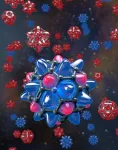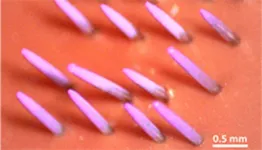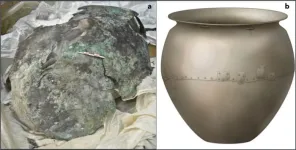(Press-News.org) In a recent Science paper, researchers led by JILA and NIST Fellow Jun Ye, along with collaborators JILA and NIST Fellow David Nesbitt, scientists from the University of Nevada, Reno, and Harvard University, observed novel ergodicity-breaking in C60, a highly symmetric molecule composed of 60 carbon atoms arranged on the vertices of a “soccer ball” pattern (with 20 hexagon faces and 12 pentagon faces). Their results revealed ergodicity breaking in the rotations of C60. Remarkably, they found that this ergodicity breaking occurs without symmetry breaking and can even turn on and off as the molecule spins faster and faster. Understanding ergodicity breaking can help scientists design better-optimized materials for energy and heat transfer.
Many everyday systems exhibit “ergodicity” such as heat spreading across a frying pan and smoke filling a room. In other words, matter or energy spreads evenly over time to all system parts as energy conservation allows. On the other hand, understanding how systems can violate (or “break”) ergodicity, such as magnets or superconductors, helps scientists understand and engineer other exotic states of matter.
In many cases, ergodicity breaking is tied to what physicists call “symmetry breaking.” For example, the internal magnetic moments of atoms in a magnet all point in one direction, either “up” or “down.” Despite possessing the same energy, these two distinct configurations are separated by an energy barrier. The “symmetry breaking” refers to the system assuming a configuration with lower symmetry than the physical laws governing its behavior would allow, such as all magnetic moments pointing “down” as the default state. At the same time, since the magnet has permanently settled into just one of two equal-energy configurations, it has also broken ergodicity.
Symmetry breaking: magnets and footballs
To understand rotational ergodicity breaking, postdoctoral researcher and lead author, Lee Liu explained: “Consider a football thrown in a tight clockwise spiral. You would never see the football spontaneously flip 180 degrees end-over-end in mid-flight, going from a low-energy 90-degree configuration to a 180-degree one! This is shown in figures 1B and 1C. This would require overcoming an energy barrier. So a spiraling football maintains its end-to-end orientation in free flight, breaking ergodicity and symmetry like a magnet does.”
However, unlike footballs, isolated molecules must obey the rules of quantum mechanics. Specifically, the two ends of an ethylene molecule (a quantum analog of a football) are indistinguishable (figure 1C). Thus, reorienting a spinning ethylene molecule 180 degrees end-over-end also entails overcoming an energy barrier; the initial and final states are indistinguishable. The molecule does not have two distinct end-to-end orientations to choose from, and symmetry and ergodicity are restored, meaning that the molecule’s ground state is a combination, or the superposition, of both the final and initial states.
Infrared spectroscopy of C60
To probe the rotational dynamics of the C60 molecule, the researchers turned to a technique pioneered by the Ye group in 2016: combining buffer gas cooling with sensitive cavity-enhanced infrared spectroscopy. Using this technique, the researchers measured the infrared spectrum of C60 with 1000-fold higher sensitivity than previously achieved. It involved shining laser light on C60 molecules and “listening” to the frequencies of light they absorb. “Just like the sound of an instrument can tell you about its physical properties, molecular resonant frequencies, encoded in its infrared spectrum, can tell us about the structure and rotation dynamics of the molecule,” said Liu. Rather than physically rotating the molecule faster and faster, the researchers probed a gas-phase sample of many C60 molecules in which some rotated rapidly and some slowly. The resulting infrared spectrum contained snapshots of the molecule at various rotation speeds. “Stitching of these traces together generated the complete spectrum, unraveling the full picture of the ergodicity evolution (or breaking) of the molecule,” elaborated Dina Rosenberg, a fellow postdoctoral researcher in Ye’s group.
Through this process, the researchers uncovered an astonishing behavior of C60: spinning it at 2.3 GHz (billion rotations per second) makes it ergodic. This ergodic phase persists until 3.2 GHz when the molecule breaks ergodicity. As the molecule spins faster, it reverts back to being ergodic at 4.5 GHz. This peculiar switching behavior surprised the researchers, as ergodicity transitions typically occur only once the energy increases and in one direction. Curious, the team dove further into the spectrum to understand where this behavior originated.
Ergodicity breaking—Quantum Football, Frisbee, and Soccer
By analyzing the infrared spectrum, the researchers could infer deformations of the molecule induced by its rotation. As Liu elaborated: “Just like drag race car’s tires bulge more when rotated at a faster rate, the rotation rate of C60 dictates its structural deformation. The infrared spectra imply that two possibilities occur when the C60 rotation rate hits 2.3 GHz: It can flatten out into a frisbee shape or elongate into a football shape. The former occurs if it is rotating about a pentagon, and the latter if it is rotating about a hexagon (figure 1D). When C60 reaches 3.2 GHz, hexagonal and pentagonal rotations result in football-like deformation (figure 1E). At 4.5 GHz, hexagonal rotation generates a frisbee-like deformation while pentagonal rotation generates a football-like deformation.” As it turns out, the peculiar ergodicity transitions of C60 could be attributed entirely to this sequence of deformations induced by the molecule’s rotation.
Breaking Ergodicity But Not Symmetry
In the gas phase, C60 molecules collide so infrequently that they behave as if they were isolated, meaning that the indistinguishability of each carbon atom in C60 becomes important. Therefore, spinning the molecule about any pentagon is equivalent to spinning it about any other pentagon (see the red Xs in Figure 1D). Likewise, spinning the molecule about any hexagon is equivalent to spinning it about any other hexagon (see the blue Xs in Figure 1D). Just as in ethylene, the quantum indistinguishability of C60‘s carbon atoms restores the symmetry of the pentagonal and hexagonal rotational sectors. Nevertheless, the researchers’ data showed that the molecule’s rotation axis never switched between sectors.
The data showed two reasons for this rotational isolation around a single axis. At rotation rates below 3.2 and above 4.5 GHz, the pentagonal and hexagonal rotational sectors are isolated due to energy conservation. “It takes more energy to spin a football than a frisbee [due to its mass],” said Liu. In this range, the C60 molecules are ergodic as the pentagonal and hexagonal sectors explore all possible states in distinct energy ranges, just as in the case of ethylene. This corresponds to the fact that red and blue crosses in the energy surface of Figure 1D exist at different energy values.
At rotation rates between 3.2 and 4.5 GHz, pentagonal and hexagonal sectors exist in the same energy range. “This is because spinning a hexagonal and a pentagonal football can take the same amount of energy,” said Liu. “Nevertheless, C60 still fails to switch between the two rotational sectors because of an energy barrier—the same barrier that prevents a football from flipping end-over-end mid-flight. In this regime, therefore, C60 has broken ergodicity without breaking symmetry. This mechanism of ergodicity breaking without symmetry breaking, which can be understood simply in terms of deformations of a spinning molecule, was a total surprise to us,” said Liu. These results reveal a rare example of ergodicity breaking without symmetry breaking, giving further insight into the quantum dynamics of the system.
As the researchers surmise, many other molecular species await detailed investigation using the team’s new technique. “Molecules will likely harbor many more surprises, and we’re excited to discover them.”
END
A new “spin” on ergodicity breaking
2023-08-18
ELSE PRESS RELEASES FROM THIS DATE:
UH leading multi-institutional program to provide research opportunities to postbaccalaureates
2023-08-18
With the juggling act of maintaining grades while also keeping a job, undergraduate students pursuing STEM degrees often graduate without any research experience, despite the benefits that research can have on their careers.
To provide more graduates from diverse backgrounds with research and mentoring experiences, Rebecca Zufall and Richard Meisel, associate professors of biology and biochemistry at the University of Houston’s College of Natural Sciences and Mathematics, are leading a multi-institutional program that will provide ...
Scientists develop efficient spray technique for bioactive materials
2023-08-18
Rutgers scientists have devised a highly accurate method for creating coatings of biologically active materials for a variety of medical products. Such a technique could pave the way for a new era of transdermal medication, including shot-free vaccinations, the researchers said.
Writing in Nature Communications, researchers described a new approach to electrospray deposition, an industrial spray-coating process. Essentially, Rutgers scientists developed a way to better control the target region within a spray zone as well as the electrical properties of microscopic ...
Public may overestimate pushback against controversial research findings
2023-08-18
Controversial research can put people on the defensive and may even lead to calls to censor findings that conflict with a particular ideological perspective. However, a pair of studies published in Psychological Science, by authors Cory J. Clark (University of Pennsylvania), Maja Graso (University of Groningen), Ilana Redstone (University of Illinois Urbana-Champaign), and Philip E. Tetlock (University of Pennsylvania), suggest a tendency to overestimate the risk that research findings will fuel public support for harmful actions.
Harmful actions related to research findings, according ...
UArizona Cancer Center study connects research scientists with the communities they serve
2023-08-18
A new study by University of Arizona Cancer Center researchers piloted a unique outreach strategy to foster dialogue between basic scientists and community members to demystify basic science research and facilitate culturally tailored approaches to address health disparities of vulnerable communities.
The paper, published in the journal Cancer Causes and Control, analyzes the processes, experiences and lessons learned during the establishment of the Research Outreach for Southern Arizona, or ROSA, program.
“Basic science research is critical ...
JMIR AI now included in the Directory Of Open Access Journals (DOAJ)
2023-08-18
(Toronto, August 18, 2023) JMIR Publications is happy to announce that JMIR AI has been accepted and indexed with the Directory of Open Access Journals (DOAJ). The DOAJ applies strict criteria to review and index Open Access journals, which include licensing and copyright criteria, quality control processes, journal website technical and usability setups, and editorial evaluation.
JMIR AI (JMIR AI ISSN 2817-1705, Editors-in-Chief: Khaled El Emam, PhD and Bradley Malin, PhD) is a new journal (launched in 2022) focusing on the applications of AI in health settings. This includes contemporary developments as well as historical examples, with an emphasis on sound ...
Prostate cancer drug shows promise against COVID
2023-08-18
At the outset of the COVID pandemic, men appeared to suffer higher rates of severe illness and death, leading researchers to suspect a link between androgen receptors—which bind to hormones like testosterone--and SARS-CoV-2 viral infection.
This observation spurred Michigan Medicine researchers to look into a drug in development to treat prostate cancer called proxalutamide, which works by blocking an enzyme called TMPRSS2 (transmembrane protease, serine 2) that is regulated by androgen receptors, as a potential therapeutic for COVID.
“We were already studying TMPRSS2 as part of the key gene driver ...
NYU Langone Health to Hold AI “Prompt-a-thon” Event
2023-08-18
NYU Langone Health’s MCIT Department of Health Informatics, Institute for Innovation in Medical Education, and Institute for Excellence in Health Equity will hold the first Generative AI Prompt-A-Thon in Health Care on Aug 18. During the event, teams of clinicians, educators, and researchers will work together to find artificial intelligence (AI)-powered solutions to healthcare challenges using real-world, de-identified patient data.
The event addresses large language models (LLMs) that predict likely options for the next word in any sentence, paragraph, or essay, based on how real people used words in context billions of times in documents on the internet. Also called ...
Ancient metal cauldrons give us clues about what people ate in the Bronze Age
2023-08-18
Archaeologists have long been drawing conclusions about how ancient tools were used by the people who crafted them based on written records and context clues. But with dietary practices, they have had to make assumptions about what was eaten and how it was prepared. A new study published in the journal iScience on August 18 analyzed protein residues from ancient cooking cauldrons and found that the people of Caucasus ate deer, sheep, goats, and members of the cow family during the Maykop period (3700–2900 BCE).
“It’s really exciting to get an idea of what people were making ...
US can cut building emissions by up to 91%, saving $100 billion per year in energy-related costs, modeling study shows
2023-08-18
The US has committed to reaching net-zero emissions by 2050. To accomplish this goal, large cuts in emissions are necessary, especially in high-emission sectors like the building industry. In an article publishing on August 18 in the journal One Earth, a team of researchers use a computational model to analyze several scenarios of future building energy use in the US. They find that by tackling emissions on multiple fronts and placing focus on “demand-side measures” that affect how power is drawn from the ...
Stanford study shows how the meat and dairy sector resists competition from alternative animal products
2023-08-18
The summertime barbecue – an American tradition synonymous with celebrating freedom – may be tainted by a decidedly unfree market. A new Stanford study reveals how meat and dairy industry lobbying has influenced government regulations and funding to stifle competition from alternative meat products with smaller climate and environmental impacts. The analysis, published Aug. 18 in One Earth, compares innovations and policies related to plant-based meat alternatives and lab-grown meat in the U.S. and European Union. Its findings could help ensure ...





